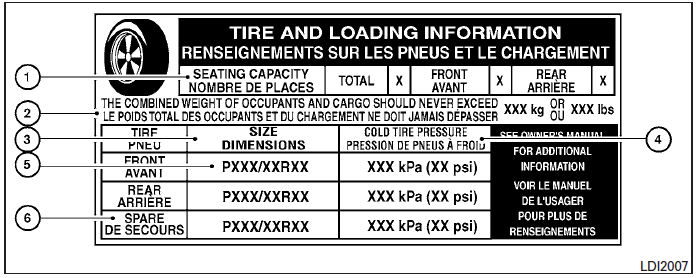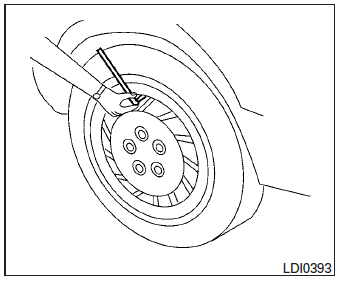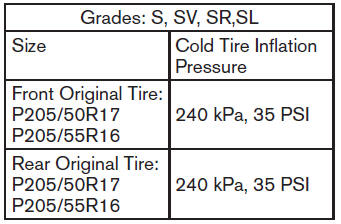Nissan Sentra Owners Manual: Tire pressure
Tire Pressure Monitoring System (TPMS)
This vehicle is equipped with the Tire Pressure Monitoring System (TPMS). It monitors tire pressure of all tires except the spare. When the low tire pressure warning light is lit and the CHECK TIRE PRES warning is displayed in the odometer, one or more of your tires is significantly under-inflated.
The TPMS will activate only when the vehicle is driven at speeds above 16 MPH (25 km/h). Also, this system may not detect a sudden drop in tire pressure (for example a flat tire while driving).
For more details, refer to ŌĆ£Low tire pressure warning lightŌĆØ in the ŌĆ£Instruments and controlsŌĆØ section, ŌĆ£Tire Pressure Monitoring System (TPMS)ŌĆØ in the ŌĆ£Starting and drivingŌĆØ section, and ŌĆ£Flat tireŌĆØ in the ŌĆ£In case of emergencyŌĆØ section.
Tire inflation pressure
Check the tire pressures (including the spare) often and always prior to long distance trips. The recommended tire pressure specifications are shown on the F.M.V.S.S./C.M.V.S.S. certification label or the Tire and Loading Information label under the ŌĆ£Cold Tire PressureŌĆØ heading.
The Tire and Loading Information label is affixed to the driver side center pillar. Tire pressures should be checked regularly because:
- Most tires naturally lose air over time.
- Tires can lose air suddenly when driven over potholes or other objects or if the vehicle strikes a curb while parking.
The tire pressures should be checked when the tires are cold. The tires are considered COLD after the vehicle has been parked for 3 or more hours, or driven less than 1 mile (1.6 km) at moderate speeds.
The ŌĆ£TPMS with Easy Fill Tire AlertŌĆØ provides visual and audible signals outside the vehicle for inflating tires to the recommended COLD tire pressure. For more information, see ŌĆ£TPMS with Easy Fill Tire AlertŌĆØ in the ŌĆ£Starting and drivingŌĆØ section.
Incorrect tire pressure, including under inflation, may adversely affect tire life and vehicle handling.
WARNING
|
Tire and loading information label

- Seating capacity: The maximum number of occupants that can be seated in the vehicle.
- Vehicle load limit: See ŌĆ£Vehicle loading informationŌĆØ in the ŌĆ£Technical and consumer informationŌĆØ section.
- Original tire size: The size of the tires originally installed on the vehicle at the factory.
- Cold tire pressure: Inflate the tires to
this pressure when the tires are cold.
Tires are considered COLD after the vehicle has been parked for 3 or more hours, or driven less than 1 mile (1.6 km) at moderate speeds. The recommended cold tire inflation is set by the manufacturer to provide the best balance of tire wear, vehicle handling, driveability, tire noise, etc., up to the vehicleŌĆÖs GVWR.
- Tire size ŌĆō refer to ŌĆ£Tire labelingŌĆØ in this section.
- Spare tire size.
Checking tire pressure

- Remove the valve stem cap from the tire.
- Press the pressure gauge squarely onto the valve stem. Do not press too hard or force the valve stem sideways, or air will escape. If the hissing sound of air escaping from the tire is heard while checking the pressure, reposition the gauge to eliminate this leakage.
- Remove the gauge.
- Read the tire pressure on the gauge stem and compare to the specification shown on the Tire and Loading Information label.
- Add air to the tire as needed. If too
much air is added, press the core of
the valve stem briefly with the tip of
the gauge stem to release pressure.
Recheck the pressure and add or release air as needed.
- Install the valve stem cap
- Check the pressure of all other tires, including the spare.



Example
 Wheels and tires
Wheels and tires
If you have a flat tire, see ŌĆ£Flat tireŌĆØ in the
ŌĆ£In case of emergencyŌĆØ section of this
manual. ...
 Tire labeling
Tire labeling
Federal law requires tire manufacturers to
place standardized information on the
sidewall of all tires. This information identifies
and describes the fundamental
characteristics of the tire and al ...
Other materials:
Power steering
WARNING
If the engine is not running or is turned
off while driving, the power assist for
the steering will not work. Steering will
be harder to operate.
When the power steering warning light
illuminates with the engine running,
there will be no power assist for th ...
Service data and specifications
(sds)
Periodical Maintenance Specification
ENGINE COOLANT CAPACITY (APPROXIMATE)
Radiator
Thermostat
Water Control Valve
...
Parking brake shoe
Adjustment - Drum Brake
If equipped with drum brakes, refer to PB-11, "Inspection and
Adjustment".
Adjustment - Disc Brake
Adjust parking brake lever stroke. Refer to PB-4,
"Inspection and Adjustment".
Perform parking brake break-in (drag on) operation by
d ...
